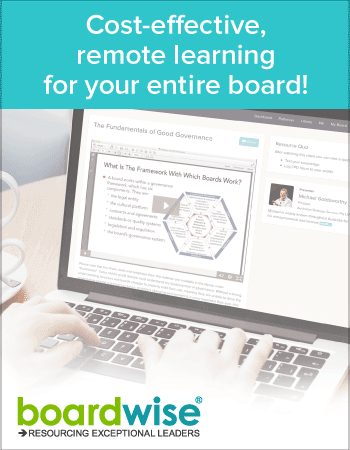glossary
Action Items
Governance GlossaryPublished: July 14, 2023

Action Item Definition:
An action item is a specific task or deliverable that is assigned to a designated owner during a board meeting. Action items drive accountability and ensure priorities discussed get translated into concrete next steps that can be executed after the meeting concludes.
Why are action items important?
Action items play an integral role in maximising the output and follow-through from board meetings. They provide clarity around who is responsible and accountable for what coming out of the meeting. They enable accountability across time and future meetings.
Well-defined action items share the following characteristics:
-
Specific: The task or deliverable is clearly articulated in detail vs. vague directives open to interpretation.
-
Measurable: There is a defined end product, milestone, or metric for assessing completion vs. an open-ended assignment.
-
Achievable: The scope of effort is realistic vs. overly burdensome given other priorities and capacity.
-
Relevant: The action ties directly back to priorities and goals discussed in the meeting.
-
Time-bound: Deadlines or target dates for completion are established.
-
Assigned: A specific owner responsible is designated.
-
Tracked: Progress is monitored through a shared action tracker log rather than falling through the cracks over time.
Well-defined action item examples
Here is a comparison of some well written and poorly written actions.
| Poorly Written Actions | Well Written Actions |
|---|---|
| Someone should look into potential offsite locations for the retreat. | Susan will book the offsite venue for the annual board strategic planning retreat by Friday and send calendar invites to all directors. |
| The crisis comms plan needs updated. | Tom will update the board crisis communications plan to reflect feedback on spokesperson roles and run draft messages by the board chair before the next meeting. |
| Maybe we should think about virtual meetings at some point. | Nancy will research virtual meeting platform options and pricing to support a hybrid in-person/virtual board meeting format starting in Q3. |
| It could be good to explore new board software. | John will schedule a demo of the ABC board management software with the executive team to evaluate capabilities before the end of the month. |
| We need some new board members. | The governance committee will review board composition gaps and nominate 3 potential new member candidates for consideration by August 1st. |
Note that the last “well written” example does not specify a person, this is because this action item would be passed to the governance committee who would then break it down to more discreet sets of actions each with their own assignees. However to improve it you might specify as “Jill will inform the governance committee it will need to review board composition gaps and nominate 3 potential new member candidates for consideration by August 1st.”
Capturing Quality Action Items
High-quality action items don’t just happen organically. They require thoughtful design and facilitation.
-
Schedule time in the agenda at the end of the meeting to recap action items before participants forget or disengage.
-
Maintain a visible list for the group to track items in real time as they emerge during the meeting.
-
Clarify ambiguous suggestions into concrete next steps with owners before finalising the list.
-
Prioritise what’s most important vs. nice-to-have.
-
Confirm understanding with the assigned owners before wrapping the meeting.
-
Delegate recapping and follow up in the meeting minutes to keep top of mind.
-
Log approved items into a shared action tracker the board can access post-meeting.
Driving Accountability
Capturing clear action items is an important first step but consistent follow through determines whether they get done.
-
Set calendar reminders for action item deadlines to avoid surprises and last minute work.
-
Include progress updates as a standing agenda item in future board meetings.
-
Review priority overdue items and reassign if owners are overextended.
-
Celebrate completed items while assessing roadblocks on remaining open tasks.
-
Analyse trends around action item completion rates to identify recurring accountability issues.
-
With disciplined capture, tracking and review of board meeting action items, boards can transform strategic discussions into well defined work streams that deliver measurable results.
Further Resources
Run a Board Meeting that’s Effective and Productive
Company Secretary Playbook: Effective Board Meetings
Three Essentials of Successful Meetings
Frequently Asked Questions
What are the best action items for a meeting agenda?
The best action items are specific, assign clear owners, have deadlines, and directly advance priorities discussed in the meeting. For example, 'John to circulate the draft board remuneration policy for feedback by Friday'.
What is an example of an action item?
An example action item is 'Susan will book the offsite venue for the strategic planning retreat by the end of next week and send invites to directors'.
What are action items vs agenda items?
Agenda items are the list of topics to cover during the meeting. Action items capture the concrete next steps and owners assigned to move items forward after the meeting concludes.
How do you identify action items in a meeting?
Listen for suggestions around next steps, decisions made, or follow-ups needed during the meeting discussion. Capture these tangible tasks with owners in a visible list as the meeting progresses.
How do I make a list of action items?
Maintain a running list during the meeting. At the end, review the draft list to ensure items are specific, assigned, and relevant before finalising.
How do you write action items in meeting minutes?
Include a section in the minutes listing the finalised actions, owners, and deadlines for follow-up. Highlight priority critical actions.
How do you make a meeting actionable?
Clarify desired outcomes upfront, facilitate discussions toward decisions, formally capture action items before closing, and review progress at the next gathering.




